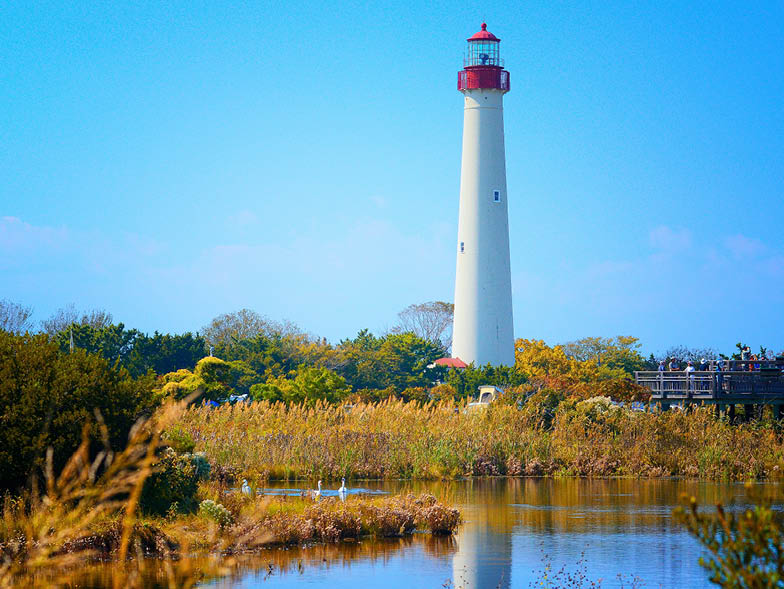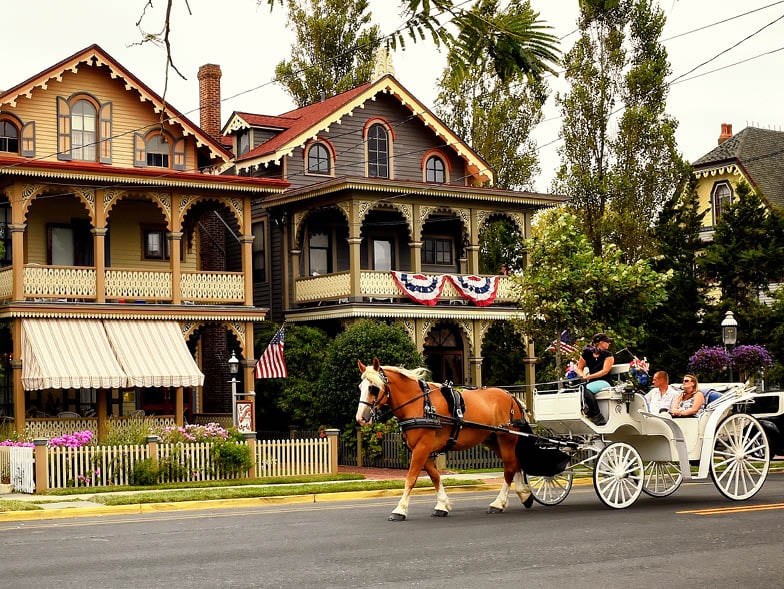Take a drive down the New Jersey coast and you’ll encounter plenty of photo opportunities—dynamically designed houses propped on stilts surrounded by gray-and-white-pebbled lawns, bicyclists strapped with surfboards and beach towels, and weather-worn mom-and-pop shops touting everything from freshly made bagels to hermit crabs.
But the scenery changes when you get to the state’s southernmost point: Cape May. You’ll still find beachgoers on bikes and sea-sprayed storefronts, but you’ll notice that the strikingly modern homes found in some coastal towns, with their random portholes and Picassoesque frameworks, are nowhere to be found—at least not in the town’s historic district.
This district spans 380 acres and is made up of 600 famous buildings, and even though the Victorian-era dwellings have been around for over 150 years, it wasn’t until around 40 years ago that Cape May Historic District was declared a National Historic Landmark. Today, Cape May is recognized as one of many historically important places in the US, with visitors coming from all over the world to tour the town’s famous feats of architecture.

© CapeMay.com
America’s Premier Seaside Town
At first glance, many of Cape May’s Victorian buildings have similar features—pitched roofs, ornate porches, and colorful framing—but each house is actually quite unique and has the history to back it up. Visitors can see a number of different styles by walking just a few blocks. Carolyn Pitts, who supervised the recording of Cape May’s architecture and was instrumental in the town’s declaration as a National Historic Landmark, even said that Cape May is “the best textbook of Victoriana in the nation.”
There are a number of different documented styles of Victorian architecture across the town—Queen Anne, Medieval Revival, and Bungalow, to name a few. The American Italianate style is represented at the Levy-Neafie House—the only private estate in Cape May still standing. The Carpenter Gothic style can be found at the Eldridge Johnson House (also known as the Pink House), which receives a lot of praise for having the most decorative porch in town. There are also a number of other Gothic-style cottage homes, such as the Joseph Hall Cottage and the J. Stratton Ware House.
At the turn of the nineteenth century, wealthy families began building homes along New Jersey’s southern tip during the Industrial Revolution because of the area’s close proximity and easy access to Philadelphia, New York, and Washington, DC. Industrialization allowed carpenters to flex their skills with power tools—experimenting with new patterns and designs in the framework and forming the gingerbread-style Victorian homes.

© CapeMay.com
“From the whaling and shipbuilding days, there had emerged a community of carpenters who became even more creative with the invention of scroll and steam-powered saws,” says Karen Fox, Cape May historian and author of The Chalfonte. “They carved gable trim, balusters, and arches, made sawtooth siding, pierced cornice brackets, and cut lacey balustrades. They turned plain frame boxes into works of wooden art.” The construction of many of these original buildings coincided with Cape May’s growth as a bustling beach town during the mid-1800s.
Among the most famous buildings constructed in these years is the Chalfonte Hotel—the oldest original hotel in Cape May (and one of the oldest in the US). It was built in America’s centennial year by Civil War hero Henry Sawyer, and it has been reconstructed several times due to fires that swept through the town in the late 1800s. “The Chalfonte is often described as an overgrown wedding cake,” says Fox. “But it is considered American Bracketed Villa—a stylistic hybrid.” The hotel has hosted innumerable guests through the years and, in the early twentieth century, it served as a summer retreat for wealthy southern vacationers, who were brought in by the new owner, Susie Satterfield.
The Rebirth of Cape May
The hype of Cape May among vacationing families died down after the early twentieth century because of interest in other South Jersey hotspots like Atlantic City. However, it was revived in the 1960s, when a group of interested preservationists decided to stop the destruction of the town’s historic buildings. Through the work of architectural historian Pitts and the Historic American Buildings Survey, the group worked to catalog Cape May’s most important structures. Pitts recruited a team of architects to create detailed pen-and-ink drawings of twenty-nine of the homes—an effort called Operation Gingerbread.
The drawings were responsible for Cape May Historic District’s designation as a National Historic Landmark in 1976 and helped revive interest in the historic buildings that dot the town’s streets. “It was becoming obvious that Cape May’s past could well be its most valuable asset in the future,” says Fox. And, thankfully for the millions of people who are able to enjoy Cape May’s architecture each year, Pitts’ and her team’s efforts paid off.

© CapeMay.com

© CapeMay.com

© CapeMay.com

© CapeMay.com

© CapeMay.com

© CapeMay.com
Preserving this splendor and tradition of Cape May makes the town feel truly distinct from the rest of the state’s summer destinations. New Jersey is full of family-friendly beaches, but Cape May has something a little bit different. Visitors can stroll down Washington Street or Beach Avenue (the two main thoroughfares in town) and feel like they stepped into another century entirely. Tours of some of the most prominent homes, the restored World War II Lookout Tower, and a critical piece of the Underground Railroad, as well as a moonlight ride through the historic district, give visitors a comprehensive look at not only how the town has changed throughout the years but also how it has stayed the same.
Fox says that when she first discovered Cape May in the 1960s, the architecture was essentially abandoned, disregarded in favor of more contemporary construction projects. But over the last quarter century, she has had the pleasure of witnessing these buildings come back to life. “Today, the nation’s first resort by the sea is a romantic, colorful, and architecturally preserved National Historic Landmark city,” says Fox. “It’s beloved for its friendly culture, the beauty of its homes and gardens, its beaches and bikeways, its abundant local produce and wine, and its diverse dining, music, and theater.”
Without its vast collection of nineteenth-century vacation homes, Cape May would still exist as a resort town. It would bring in tourists eager to hit the beaches and local ice cream shops, purchase postcards from five-and-dimes, and take turns building sandcastles. The architecture is not the only thing to see in Cape May, but it is the thing to see—and the glue that holds it all together.



